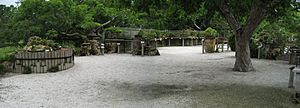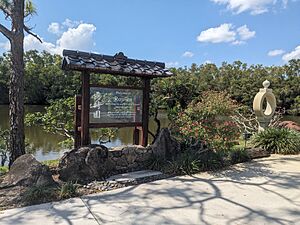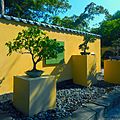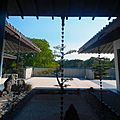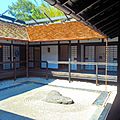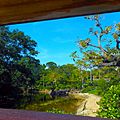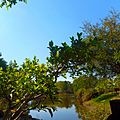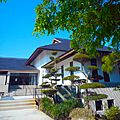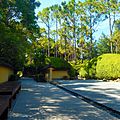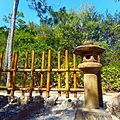Morikami Museum and Japanese Gardens facts for kids
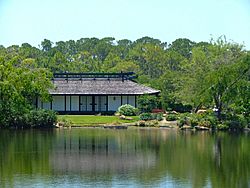
The Yamato-kan, a Japanese style house in the Morikami Museum and Japanese Gardens
|
|
| Lua error in Module:Location_map at line 420: attempt to index field 'wikibase' (a nil value). | |
| Established | 1977 |
|---|---|
| Location | 4000 Morikami Park Road Delray Beach, FL 33446 (United States) |
| Type | Art center, Art museum, Gardens |
The Morikami Museum and Japanese Gardens is a special place in Delray Beach, Florida. It's a center where you can learn all about Japanese art and culture. The museum has two main buildings, beautiful Japanese gardens, a bonsai garden, a library, a gift shop, and a Japanese restaurant called the Cornell Cafe. You can see different art exhibits that change often. They also have fun demonstrations, like traditional tea ceremonies and classes. Several times a year, the museum celebrates Japanese festivals.
The museum and park are named after George Morikami. He was from Miyazu, Japan. George Morikami gave his farm to Palm Beach County so it could become a park. He was the only person from the Yamato Colony, Florida who stayed in Delray Beach after World War II. The museum first opened in 1977 in a building now called the Yamato-kan. The main museum building opened later in 1993. The beautiful Roji-en gardens started being built in 1993.
Morikami Park, which includes the museum, is very large, covering about 188.5 acres. It has picnic areas and a playground. You can also find memorials there, like the Challenger Astronaut Memorial.
The Morikami Museum and Gardens host many exciting Japanese festivals each year. These include Oshogatsu (New Year's) in January, the Hatsume Fair Festival in April, and the Lantern Festival in October. The Lantern Festival is based on the Japanese Obon festival. These events bring visitors from all over Florida. They feature delicious food and art vendors. The Lantern Festival also has drum performances and interactive dances. Visitors can even release lanterns onto the central lake after the sun sets.
Exploring the Museum
The first museum building, called Yamato-kan, looks like a traditional Japanese house. It has a special dry garden and an exhibit about the history of the Yamato Colony. There's also a fun, hands-on exhibit called "Japan Through the Eyes of a Child."
The main museum building has three exhibit areas, a theater with 225 seats, a tea house, and classrooms. It also has a research library, a store, and the Cornell Cafe. The Morikami's collection has more than 7,000 amazing artifacts.
From May 2024 until August 2024, the museum showed an exhibit called The Hapa Project by Kip Fulbeck. Other past exhibits have included Painting Enlightenment: The Art and Science of the Heart Sutra. This exhibit explored how Buddhist art and modern science connect. The museum also featured Nature, Tradition, and Innovation: Contemporary Japanese Ceramics. This showed how Japanese ceramic art has changed over time.
Visitor Information
The Morikami Museum and Gardens make sure everyone can visit. They have paths that are easy for wheelchairs, and you can ask for a wheelchair if you need one. Guided tours are available for groups. The Cornell Café serves real Japanese food and has options for different diets. You can sit outside and enjoy views of the gardens while you eat.
The museum also offers regular cultural demonstrations. These include tea ceremonies and rock garden raking events. They are a great way to see famous Japanese traditions up close.
Discovering the Gardens
The Roji-en Japanese Gardens were designed to go perfectly with the museum. There are six gardens in Roji-en. Each one is inspired by famous garden styles from different times in Japan's history. Hoichi Kurisu designed them, and they were finished in 2001.
The six historical gardens are:
- Shinden Garden: This garden is like those from the Heian period (9th–12th centuries). Japanese nobles used Chinese garden designs with lakes and islands. People usually viewed these gardens from a boat.
- Paradise Garden: These gardens come from the Kamakura and Muromachi periods. They were designed as temples to the Buddha and showed what Buddhist Heaven might look like.
- Early Rock Garden: Also from the Muromachi period, these gardens were influenced by Chinese art and early Zen ideas.
- Karesansui Garden: These Muromachi period gardens are in true Zen style. You don't walk through them. Instead, you view them from temples and think about them. These "dry landscape" gardens have very few plants, mostly rocks and gravel.
- Hiraniwa Garden: The Edo period was known for this Flat Garden style. These gardens mix ideas from late rock gardens and tea gardens. They often have special touches like pagodas, lanterns, and stepping stones.
- Modern Romantic Garden: This garden style started during the Meiji period. It was inspired by nature and Western ideas.
The Morikami Museum and Japanese Gardens also take part in the Gardens for Peace project every year. This project helps bring communities together in Japanese gardens to promote peace. As part of this, the museum shows rock garden raking demonstrations in its Late Rock Garden. They even create designs that symbolize peace, like the Japanese characters for heiwa (peace).
Images for kids
See also
 In Spanish: Museo Morikami y Jardín Japonés para niños
In Spanish: Museo Morikami y Jardín Japonés para niños
- Boca Raton, Florida
- Yamato Colony, Florida


